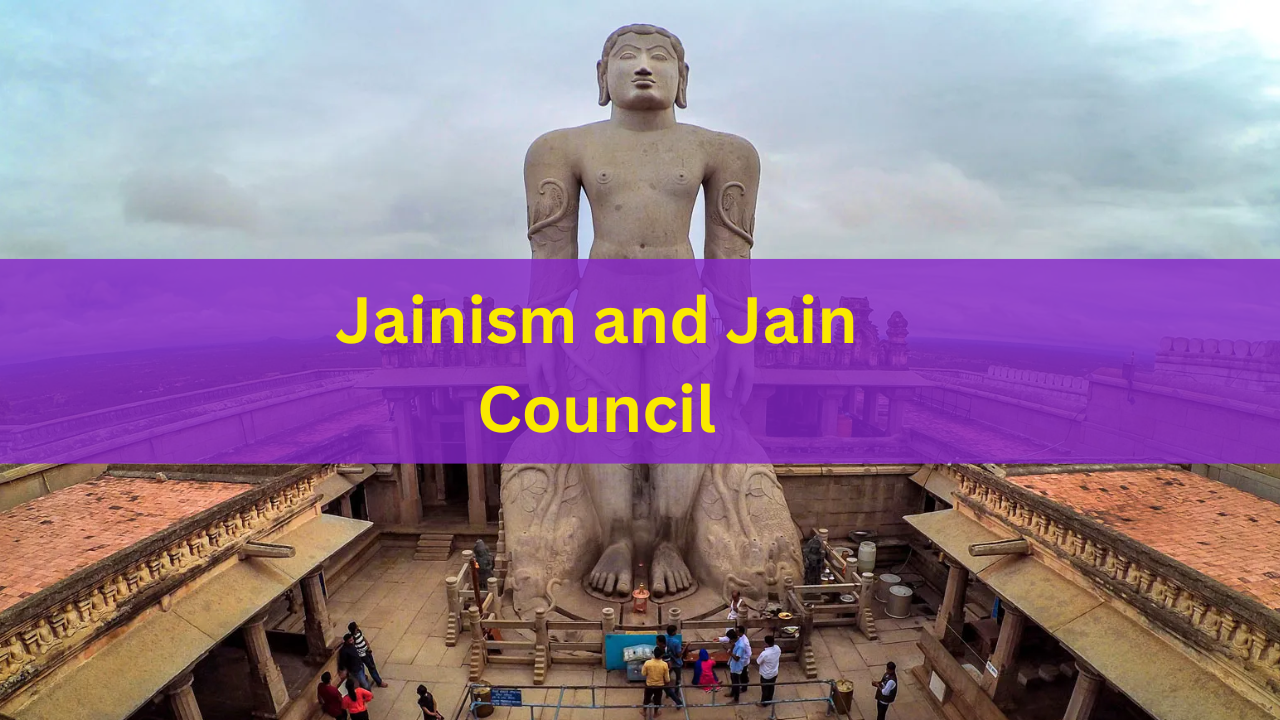Jainism and Jain Council

Jainism is one of the ancient religions, which came to prominence in the 6th century B.C. There were 24 Tirthankaras, who attained all knowledge (Moksha) while living and preached it to the people. Rishabnatha was the first Tirthankara and Lord Mahavira was the last Tirthankara. In this article, we will learn everything about Jainism including the cause of the origin of Jainism Religion, Tenets of Jainism, and many more. Let's learn.
About Jainism:
-
Period: 6th century B.C.
-
In this century, Lord Mahavira had propagated the Jain religion.
-
Total number of Tirthankaras: 24
-
First Tirthankara: Rishabnatha
-
Last Tirthankara: Lord Mahavira
-
-
All 24 Tirthankaras have attained all knowledge (Moksha) while living and preached it to the people.
-
Meaning of Jain: It is derived from Jina or Jaina, which means the ‘Conqueror’.
Cause of Origin of Jainism Religion:
-
Rigid and orthodox: Hinduism had complex rituals, which made Hinduism rigid and orthodox and the dominance of Brahmins.
-
Varna system: It has been divided into four classes based on birth
-
Reaction of Kshatriya against the Brahmanas domination.
Tenets of Jainism:
-
Aim: Attainment of liberation
-
According to the Jainism tenest, the liberation can be attained through three principles, which is known as Three Jewels (Triratna).
-
These three jewels are as follow:
-
Samyakdarshana: It means Right Faith
-
Samyakjnana: It means Right Knowledge
-
Samyakcharita: It means Right Action
-
Five Doctrines of Jainism:
-
Ahimsa: It refers to non-injury to a living being.
-
Satya: It means that nobody should speak a lie.
-
Asteya: It means that nobody should steal anything.
-
Aparigraha: It means that nobody should acquire property.
-
Brahmacharya: It refers to observing continence.
Sects/ School of Jainism:
It has been divided into two major sects i.e. Digambara and Svetambara.
About Digambara:
-
In this sect, monks believe in complete nudity.
-
Male: Male monks of this sect, do not wear clothes
-
Female: Female monks in this sect, wear unstitched plain white sarees.
-
They follow all five vows i.e. Aparigraha, Satya, Ahimsa, Asteya, and Brahmacharya.
-
They also believe that women cannot achieve liberation.
-
The exponent of this sect: Bhadrabahu
-
Major Sub-Sects: Mula Sangh, Bisapantha, Terapantha, Taranpantha or Samaiyapantha, Minor Sub-Sets, Gumanapantha, and Totapantha
Svetambara:
-
Monks of this sect, wear white clothes.
-
They follow only 4 vows of Digambara, except brahmacharya.
-
They believe, that women can achieve liberation.
-
Exponent of this sect: Sthulabhadra
-
Major Sub-Sects: Murtipujaka, Sthanakvasi, and Terapanthi
During his last years, Chandragupta Maurya (king of the Mauryan empire) became a Jain ascetic and promoted Jainism in Karnataka.
Jain Literature:
The Jain Literature is mainly divided into two parts i.e. Agam and Non- Agam.
Agam Literature:
-
Agam Literature is written in the Prakrit language.
-
It has been divided into two parts i.e. Ang-agama and Ang-bahya-agams (outside of Ang-agams)
-
Ang-agama:
-
This literature contains the direct preaching of Lord Mahavir.
-
Immediate disciples of Lord Mahavira were known as Gandhara.
-
All Ganadharas have acquired perfect knowledge.
-
-
Ang-bahya-agams (outside of Ang-agams):
-
These texts are extensive versions of Ang-agams.
-
Compiled by: Shrutakevalin
-
Non-agam Literature:
-
It consists of commentary and explanation of Agam literature.
-
It is an independent work, which was compiled by elder monks, nuns, and scholars.
Jain Architecture:
Types of Jain Architecture:
-
Layana/Gumphas (Caves)
-
Ellora Caves (Cave No. 30-35), Maharashtra
-
Mangi Tungi Cave, Maharashtra
-
Hathi-gumpha Cave, Odisha
-
Gajapantha Cave, Maharashtra
-
Udayagiri-Khandagiri Caves, Odisha
-
Sittanavasal Cave, Tamil Nadu
Jianalaya (Temple)
-
Dilwara Temple: Mount Abu, Rajasthan
-
Girnar and Palitana Temple: Gujarat
-
Muktagiri Temple: Maharashtra
Jain Council
First Jain Council
-
Location: It was held at Patliputra, Bihar
-
Period: 3rd Century B.C.
-
Presided by: Sthulbhadra
Second Jain Council
-
Location: It was held at Vallabhi, Gujarat.
-
Period: 512 A.D.
-
Presided by: Devardhi Kshmasramana
-
Final Compilations of 12 Angas and 12 Upangas.




